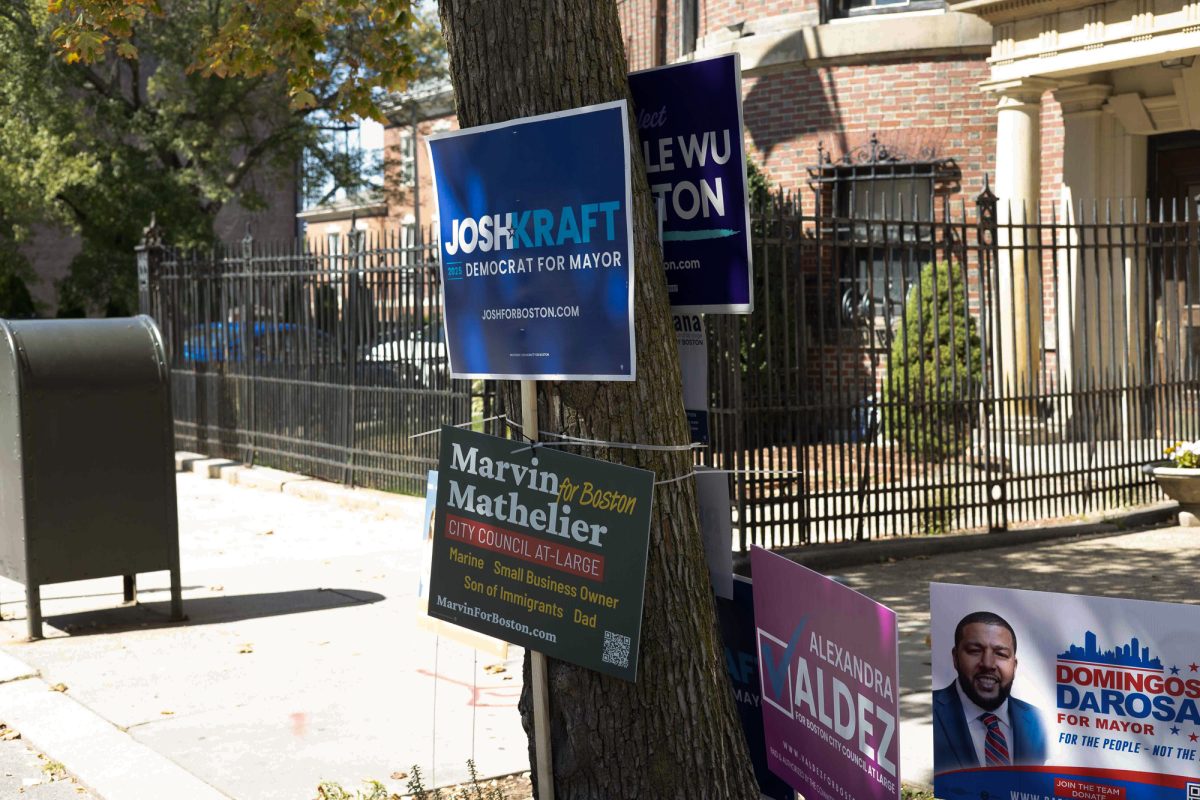When the Pan Am building rose like a massive tombstone behind New York’s Grand Central Terminal in 1963, it was almost universally reviled. It was the largest commercial office building in the world, and it had been built, according to its detractors, seemingly without consideration of architectural merit, social policy or human needs. The most pointed remarks came from Ada Louise Huxtable, the architecture critic of the New York Times, who called the building “gigantically second-rate.”
I couldn’t help but recall Huxtable’s trenchant words, and the general derision of the Pan Am building, when I visited Marciano Commons — the Frankensteinian food factory that replaced Myles, Shelton and Towers dining halls. Here, as in Pan Am, is a physical manifestation of the maxim that bigger is not always better. In fact, bigness can be blinding–especially (as I quickly noticed) when clad in a dizzying array of colors, materials and textures. One particularly obnoxious seating area sports fluorescent green tile, carpet, and paint, with matching upholstery and lighting; I felt as if I were trapped in a slice of key lime pie. The quality of the food notwithstanding, I returned from dinner that night with a bad case of architectural indigestion. Granted, it’s hard to do worse than the erstwhile subterranean Towers dining hall, but what a shame it is to have traded the rich wood paneling of Myles and the neoclassical ornamentation of Shelton for garish yet soulless walls hung here and there with meretricious corporate “art.”
The aesthetic shortcomings, bad as they are, pale in comparison to the functional and experiential deficiencies. Not surprisingly, an especially pernicious consequence of funneling all of East Campus into one cafeteria is lines: lines at the card-swipe, lines for sandwiches, lines at the grill, lines for dessert, lines for drinks, lines at the dish return. Even during off-peak hours, one can expect to wait in a seemingly interminable succession of lines just to get a sandwich and soda.
To make matters worse, the amoeboid layout of the various serving stations lacks any clear pattern of circulation. There is such a labyrinthine sequence of spaces that one half expects to find a minotaur lurking around the next corner, and the ubiquitous lines, stretching every which way, block aisles and conflate with queues at neighboring stations so that one can’t be sure whether at the end of a long wait he’ll find a bacon cheeseburger or a tofu salad.
Size matters, and there’s something to be said for modesty of scale. In Shelton, it was possible to set my bag and coat on a table and to keep an eye on it from the salad bar, a few feet away. It was also possible to view all available menu options with a 180-degree turn of the head. At Marciano Commons, though, seeing what looks good involves a complete circuit of the first floor, a hike up the stairs (over the river and through the woods…) and then another trek around the second floor. Gone are the days of a quick power lunch. Gone, too, is the sense of community that is inherent in a small dining room, where the same familiar faces greet you at every meal.
Then there are the little things: the cumbersome and propagandistic name (officially “The Fresh Food Company at Marciano Commons”); the nearly horizontal silverware baskets from which half a dozen utensils tumble to the floor whenever someone tries to grab a fork; the noise that results from herding a thousand people at once into a cavernous space, obliterating any quiet corners in which to read a book. And, though it’s not an issue yet, I expect by about mid-February, east-campus residents will long for the good old days when they could stumble downstairs in pajamas and slippers instead of trudging through a foot of snow for a bowl of cereal.
Even the Pan Am building, early on, garnered a smattering of admirers for being new and huge, and I have no doubt the same will be true of Marciano Commons. By 1987, though, Pan Am ranked at the top of New York magazine’s list of “buildings New Yorkers love to hate,” and there is every reason to expect BU’s new cafeteria will suffer a similar fate.
Novelty is fleeting, and when the virginal luster of the building fades, as it inevitably will, the only remaining distinctions will be inordinate size and brute expediency.
Sincerely, Brian M. Sirman
Lecturer/Senior Teaching Fellow and
Ph.D. Candidate
American & New England Studies Program
















































































































Tris • Sep 26, 2012 at 12:09 am
I couldn’t agree more! Towers could definitely have used a facelift but Shelton and Myles were cozy! There are ALWAYS lines at the new building and it’s so loud. Maybe big cafeterias are good for freshmen who need to meet people but juniors and seniors just want a quiet place to eat without a hassle. And I totally agree about the silverware holders. It’s like they were made on purpose to dump forks and knives all over the floor!
BU Student (who AGREES) • Sep 6, 2012 at 9:27 pm
In full agreement. I miss the weird pictures hanging on the cream walls, the three choices of foods, pizza and a fine looking salad bar with just the right amount of everything. I miss the workers faces that would greet me each day. The TV’s I could watch to catch up on the news or the latest Colbert episode. I miss the peace and quiet. The small campus feel was alive in the Towers, Shelton, and my beloved Myles dining halls. As a BU student, I do appreciate what they have done. But what could have been a lot more useful was ASKING the students if this giant facility was even needed to begin with. Perhaps, fixing up the three beloved smaller dining halls could have been an easier, and more cost-effective answer to their desire to make BU a more upscale university. Or maybe creating another GSU-like facility in east campus instead of a dining hall? Of course this isn’t something that would have ever been asked to a student. Rather, this is something for others to decide on who do not even attend the university. Maybe I am just bitter because I miss my Myles dining hall so much. Or, maybe I am just bitter because today I nearly died walking down the staircase as a cluster of freshman began stampeding towards me, grabbing onto a plate of pasta that I waited a half an hour for.
BU Student • Sep 5, 2012 at 4:20 pm
trenchant …meretricious….pernicious…..Get off your high horse and lighten up Francis
Brian • Sep 5, 2012 at 2:43 pm
Wow, what a pretentious piece.
BU creates a state-of-the-art student center, with probably the best college dining facility in the country, and you’re complaining because it’s not aesthetically pleasing enough?
Did you consider that the ridiculous lines, too, might fade when the novelty of the building wears off? Perhaps by February, people won’t be trekking from West to eat there, n’est-ce pas? And hopefully by February, you will learn where all of the food stations are so you’ll know whether you’re in line for a vegan salad or a cheeseburger.
All I can think of when reading this is the ubiquitous meme: first world problems.